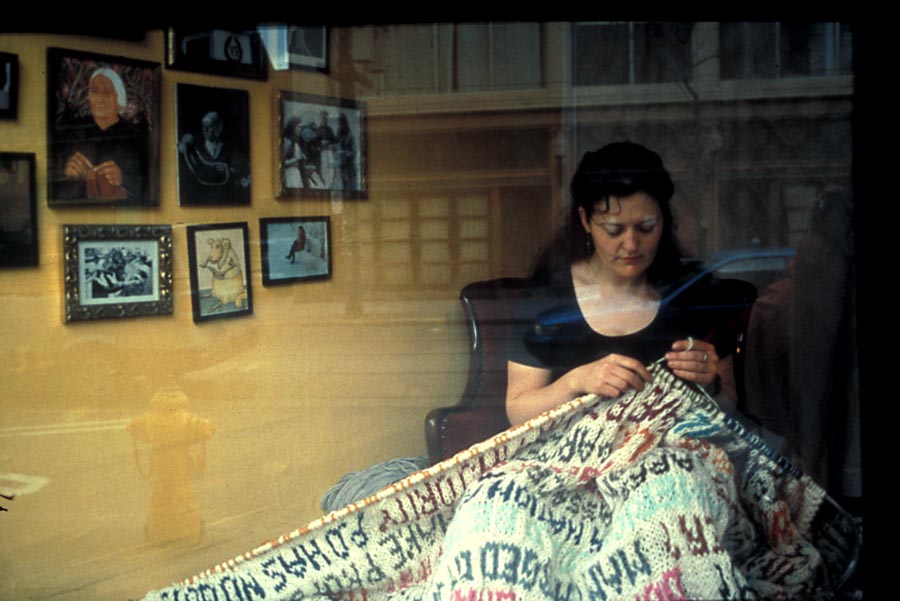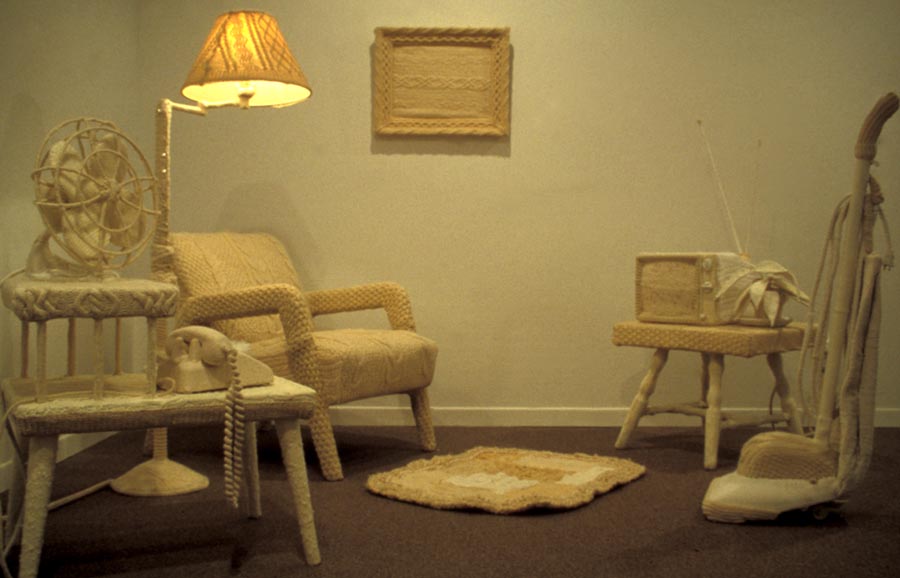
Artists Choosing Knitting Over Painting
Does it matter whether a work of art is painted on canvas, cast in bronze, or knit with yarn? An artist’s choice of materials and techniques often carries significance. Janet Morton and Freddie Robins are two artists whose work from the late 1990’s – early 2000’s use knitting and its association with women and domesticity to add layers of meaning to their artwork.
Slowing down time
Canadian artist Janet Morton creates knitted artwork and uses recycled sweaters to explore issues of consumption, value and time. Knitting takes a lot of time and Morton took advantage of that fact by chronicling the day’s news through yarn. In 1995, she staged a public performance in a store window in Toronto’s shopping district knitting a blanket of the day’s news for thirty days. The title of the piece, Newsflash, contrasted with the slowness of the way she recorded the news. In addition, the knitted blanket cumulated news from day to day.

Janet Morton, Newsflash: Madame Defarge Eat Your Heart Out (1995), photo from CCCA Canadian Art Database.
One could see “flashes” from previous days in the sections of the blanket that had been knit in previous days. Unlike paper (or now digital) news media, the handmade blanket was precious. Something created from such labor would not be thrown out like inexpensive newsprint. This news snapshot preserved the events of those thirty days in a softly draping comforter.
Uncovering the home by wrapping it in sweaters

Janet Morton, Untitled (Domestic Interior), 2000, from the CCCA Canadian Art Database.
Morton challenged the ideas of our disposable culture in her 2000 installation of a domestic interior. In the late 20th-century, while mass production of consumer goods surged, there was a counter-balancing interest in making things by hand. Along with mass-production came an attitude that objects and clothing were disposable. Household items could be thrown away when they wore out or styles changed.
Morton’s installation consisted of a room where the furniture and household objects were covered with recycled sweaters. A comfy chair, lamp, television, and vacuum cleaner were among the items cloaked in pieces of creamy Aran sweaters. The sweaters were intricate, full of twisted cable designs, bobbles, and textures. Covering these everyday objects makes the viewer pay more attention to them, and to the sweaters.
The cream color of the sweater material is gender neutral. Only the vacuum cleaner parked in the room suggests traditional female roles. The room is neat and tidy. The vacuum cleaner is parked as if its job is completed. A television and comfortable chair sit empty. One wonders if the person who was vacuuming is coming back to relax after doing the housework or is busy working elsewhere. The installation conjures up comfort and coziness, but it is unclear whether those feelings are real or mere sentimentality.
See more of Janet Morton’s work on the CCCA Canadian Artwork Database and at the website of Paul Petro Contemporary Art.
Subverting female stereotypes
Using knitting to subvert stereotypes is central to the work of British artist Freddie Robins. She uses the common art of knitting to examine “notions of the abnormal.” As she writes, “Knitting is a friendly medium that can be used to engage your audience with a subject matter that might otherwise cause them to turn away.” This is certainly true of her 2002 series Knitted Homes of Crime.
The series is comprised of soft knitted replicas of the homes and crime scenes of female murderers. Each one is the size and shape of the cute cottage-shaped tea cozies that are popular in Britain. Robins finds those cozies to be “hideous, cloying, claustrophobic objects” representing a claustrophobic life. In Knitted Homes, she exploded realities that might be hidden under their facades.

Freddie Robins, Knitted Hones of Crime (2002), installation photo at Minories Art Gallery, Colchester, England.
Each house is knit in bright innocent colors, with a childlike design quality. Each is named for the murderer and displayed with a narrative account of the crime. These works juxtapose the idea of a warm comforting domestic environment where with gruesome tales of crimes carried out in the home. The many jarring contrasts embodied in this work purposely distort accepted perceptions of female domesticity.
Ethel – 10 hours
2 Council Houses, Kirkby on Bain, Lincolnshire – 1934
Ethel Major, aged 43, lived with her husband Arthur. In 1934, after 16 years of marriage and a child of their own, Arthur discovered that Ethel already had an illegitimate daughter, Auriel. Their marriage started to deteriorate and Ethel began to imagine that he was now having an affair. As a result of her suspicions she started to poison him. Arthur eventually died on 24 May 1934 after eating corned beef sandwiches containing strychnine. Ethel was caught on the day of Arthur’s funeral when the police received an anonymous letter claiming that a neighbours dog had died after eating scraps of food from the Major’s household. After an examination of Arthur’s body and the exhumation of the dog she was charged. Ethel was found guilty of murder and hanged at Hull Prison on 19 December 1934.
Each knitted homes was carefully designed by Robins and knit by the mother of a friend, whom Robins paid a fair wage. The time it took to make each piece was listed in the exhibit next to each piece. This became another way in which Robins makes visible the invisible time spent on traditional home-based handmade work. More about Robins’ goals for this work can be found on her website and in an interview in the book Astounding Knits! 101 Spectacular Knitted Creations and Daring Feats (Voyageur Knits 2011) by Lela Nargi.
Knitting makes the point
Knitting is an essential element of these works by Janet Morton and Freddie Robins. Had Morton painted her newsflashes with quick brushstrokes, it would not have had the impact of knitting them slowly from yarn. And if Robins had carved her homes of crime from wood, they would not have subverted the ideals of domestic life. By knitting these artworks, Morton and Robins confront the viewer with questions and force them to rethink accepted notions of modern life and gender stereotypes.
This is the perfect blog for anyone artists choosing knitting over painting who wants to know about this topic.The article is nice and it’s pleasant to read. I have known very important things over here.Thank you so much for this post.
Thanks for including us in your blog email. I continue to be fascinated by what can be produced by knitting and imagination. The most inventive I was (when I knitted) was knitting mittens for very young orphan children.
Mary
Thanks, Mary. I think children are great inspiration for creative knitting!